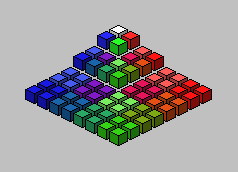 SPIHT IMAGE COMPRESSION
SPIHT IMAGE COMPRESSION SPIHT IMAGE COMPRESSION
SPIHT IMAGE COMPRESSION Technical Discussion
Technical DiscussionBelow is what can be called "graduate-level FAQ:" frequently asked questions about how SPIHT deals with the general problems of image compression, and about the material covered in the papers. Familiarity with the papers and their terminology may be required to understand the answers.
Questions about the demo programs are answered in the FAQ page.
 Coding algorithm.
Coding algorithm. Quantization.
Quantization.If you also have a question, or are not satisfied with an answer, send an e-mail to one address listed in the home page.

With SPIHT the allocation problem is replaced by a scheduling problem. When the encoder tells the decoder that a subset is insignificant, it means that at that moment zero bits are going to be used to quantize the pixels in that set. This is equivalent to say that it (the encoder) wants to know if the bits are not more "profitable" if used in other sets. The same set is visited again later, and eventually it should decide to use some bits for the quantization of its members.
There are some other implicit decisions: when a pixel becomes significant only one more bit (the sign) is used for it. Similarly, pixels gets only one bit in each refinement pass.
A. In our paper "Reversible Image compression via multiresolution representation and predictive coding", presented at the SPIE VCIP Symposium, Cambridge, MA, Nov. 1993, we proposed a transformation for lossless compression called S+P transform (Sequential + Prediction), and presented some embedded coding results with an earlier version of SPIHT.
In March of 1995 Ricoh researchers presented at the IEEE DCC, Snowbird, UT, a paper called "CREW: Compression with reversible embedded wavelets", proposing "reversible wavelets" which are equal to a special case of our S+P transform (predictor "A" in the SPIE paper), and propose a version of EZW for progressive transmission. So, the two works are indeed very similar, but the least we can say is that our work was published more than a year earlier.
We have written a case report on the precedence of our lossy-to-lossless compression method over CREW. We include here a link to this report for those who are interested. CREW Report .



 Links to other pages.
Links to other pages. SPIHT Home Page;
SPIHT Home Page;
 Properties of the Method
Properties of the Method Licensing Information
Licensing Information Demo Programs
Demo Programs Papers
Papers Demo Images
Demo Images FAQ
FAQ WWW Image Compression Resources
WWW Image Compression Resources Guest Book
Guest Book

 These pages are still
under construction. Sorry for any inconvenience...
These pages are still
under construction. Sorry for any inconvenience...
